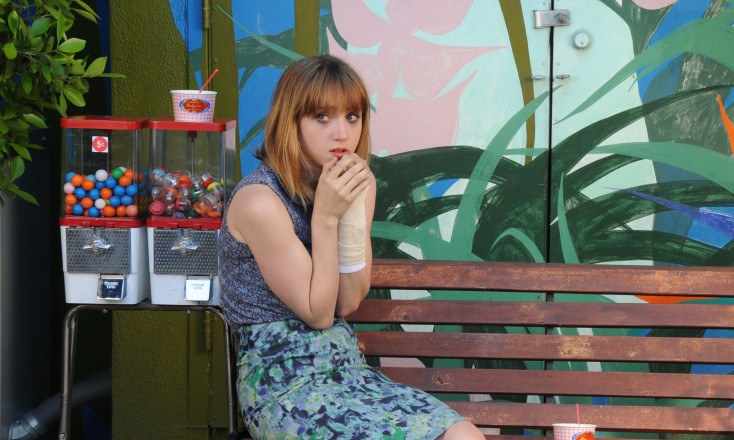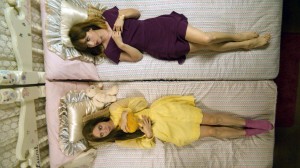By ANGELA DAWSON
Front Row Features
HOLLYWOOD—Having proved herself as a screenwriter with her much acclaimed 2012 romantic comedy “Ruby Sparks,” in which she co-starred with real life boyfriend Paul Dano, Zoe Kazan returns to the screen in a dual role in the dark comedy “The Pretty One.”
The 30-year-old plays identical twins that couldn’t be more different from one another. While Audrey is confident, stylist and independent, Laurel is awkward, homely and a homebody. On their birthday, the girls go out together and Laurel gets a makeover. On their way home, tragedy strikes, and when Laurel wakes up in the hospital, everyone thinks she’s Audrey and that Laurel is dead. Seeing an opportunity to change her life, Laurel decides to pretend to be Audrey but then discovers some of the cracks that were hidden beneath her prettier sister’s surface. Eventually, she has to come to terms with her true identity.
The film was written and directed by first-time filmmaker Jenee LaMarque, who conceived “The Pretty One” soon after discovering the subculture of twinless twins.
Inspired by smartly written independent films like “Little Miss Sunshine” and “Lars and the Real Girl,” LaMarque wrote a screenplay that uses humor as a gateway into the darkness of the grim subject matter. In auditioning Kazan, the filmmaker found a lead actress who “got” what she was aiming for.
The blue-eyed, blondish actress bears a certain resemblance to “New Girl’s” Zooey Deschanel, both physically and with her mannerisms and voice. Similarly, she hails from a family with deep roots in the filmmaking world. She is the daughter of screenwriters Nicholas Kazan and Robin Swicord (co-writers of “Matilda”), and her paternal grandparents were film and theater director Elia Kazan and playwright Molly (Thacher) Kazan. Zoe Kazan is turning out to be a formidable talent in her own right. Prior to “Ruby Sparks,” she was best known to movie audiences as the other woman in the Leonardo Di Caprio-Kate Winslet starrer “Revolutionary Road.”
She has starring roles in the upcoming “In Your Eyes,” written and produced by Joss Whedon, and she recently completed filming “The F Word,” alongside “Harry Potter” star Daniel Radcliffe.
On a recent weekday morning, she sits down in bright Sunset Boulevard hotel suite, to discuss her new film, working with a first-time director and the technical and emotional challenges of playing two characters in the film.
Q: How did the role come to you and why did you want to play Audrey/Laurel?
Kazan: I auditioned for the movie. I was really impressed in the room with Jenee. She really knows how to talk to an actor. It was one of the more enjoyable auditions that I’ve ever had. I felt like she was really watching and had really smart things to say that were helpful, which is so rare. I felt really excited because when I read the script, it had a real filmmaker’s voice behind it. Because Jenee is a first time filmmaker, I didn’t know if she could deliver on the thing she could put on the page. Afterwards, I felt like she really did.
Q: Was it confusing going back and forth between the characters? Did you go back and forth in one day?
Kazan: We did. That’s all we did. We shot all of the twin stuff in the first 10 days. Then we were done in that location and then moved on to Laurel in Audrey’s life. It was easier to be able to separate those two things. To know I’m just playing Laurel in her pre-Audrey state in this part of the movie. But the technical challenges were so difficult. The acting part of it was much easier. I’ve worked a lot on stage and I think that sort of served me in that capacity. I did “Angels in America” (on stage) in 2010, and I had to play multiple roles in that so (moving between the characters) was something I felt more familiar with. I felt like I’ve done this before, in some capacity, although technically I hadn’t done it before. But the technical stuff like matching my performance to a performance I hadn’t done yet was tough.
Q: What helped you?
Kazan: I worked with this body double, Katherine Macanufo, who was wonderful. She acted opposite me, but her performance was not the performance that I would give. It was wonderful to have someone there to play with, but I also had to anticipate what I might do once I went onto the opposite side. I was trying to give Jenee options for the editing room of two performances that would make sense together. So I had to anticipate how I was going to play things, and just the silly challenges like matching Laurel’s eye line to something that isn’t there because we couldn’t have someone crossing in both plates. In the party scene, for example, the guy I like is crossing frame, and there was no one was actually doing it, so I had to anticipate the speed he was walking and his height and stuff like that. So it was a lot harder than I anticipated it would be. It’s a lot like skydiving. You just have to jump into it.
Q: Did you have to prepare physically and vocally for each twin and then internalize it?
Kazan: So much of it was on the page already. Jenee and I sat down for many months and went really slowly through the script so that I understood exactly how she saw these people and what was happening in every scene. I just asked things like, “Is this line supposed to be funny?” There’s a comic-tragic tone to the thing. It kind of reminds me a little bit of one of Shakespeare’s “The Winter’s Tale.” There’s this kind juxtaposition of sadness and humor. It also has this fairy tale quality. So it was really useful for me to be able to sit down and know exactly what was supposed to be funny, because you can’t always tell. Jenee rehearsed with me and talked about (Audrey and Laurel’s) bodies and voices and all of that actor-y stuff. It always starts with the instinct of how the worlds strike you.
Q: What did you learn from working that long on the script with Jenee?
Kazan: I feel we discovered things, especially about Audrey. She’s more mysterious. She’s not our protagonist. There are things when we went through the script together, we started working on the body and voice stuff, I felt I learned a tremendous amount about who that person was. With Laurel, I sort of judged her from the outside when I first read the script. Then, as I began to work on it, I began to flesh out in my brain what her life was like.
Q: What were the technical challenges for you?
Kazan: Sometimes I think it’s almost impossible to see from the outside how hard it is to make a film, let alone make a film that you’re proud of. It’s so hard right now, especially to get an independent film made, to raise money. Every step of the way is a victory. To write something you’re proud of and to have someone recognize that, and put money behind it, and get the right people on board, I really think it’s a huge achievement just to be able to push that rock up the hill. My parents always say to me, “Celebrate now.” In other words, don’t put it off until your movie wins awards or something because that’s probably not going to happen. Your movie probably isn’t going to be made anyway. They say, “Celebrate that a director has signed on” or “You’ve got the first producer involved so celebrate.”
Q: What research did you do?
Kazan: There were these brilliant videos made by this artist called Candice Breitz. The name of the project is called “Factum.” She interviewed identical twins wearing the same clothes separately in the same location, so it looks like mirror images, and would ask them the same questions. It’s just them talking and she edited them so when one of them is talking the other is just sitting there. She asked them a lot of questions about identity and how they’re perceived, and the way that perception changed the way they think of themselves. It’s just fascinating because they look different. I also read in Freudian theory that babies go through the mirror stage. They look at themselves in the mirror and realize they have a body. They realize they’re separate from the world—the world doesn’t exist inside them, but they exist within the world. So it’s obviously a big deal to go through the mirror phase. Some psychologists think that identical twins never go through a mirror phase because always can look at their own image (through the other twin) from the time they are born, so when they see a mirror, they don’t actually read that as being themselves, they read it as being their twin. So I found that very useful in thinking about how informed Laurel’s identity is. In some way, she’s going through her mirror phase for the first time in this movie.
Q: Did you like Hayley Mills’ twin depiction in “The Parent Trap?”
Kazan: Yes, and Lindsay Lohan is incredible (in the remake). She was so amazing.






